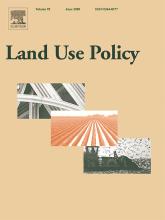Resource information
Policy makers concerned with the peri-urban interface find their greatest challenges in the rapid urban growth of developing mountain regions, since limitations caused by relief and altitude often lead to an increased competition between rural and urban land use at the valley floors. In this context, little attention has been paid to the affected agriculturalists’ perceptions of peri-urban growth—important information required for the realization of sustainable land use planning. How is the process of rural–urban land change perceived and assessed by peri-urban smallholder communities? Which are the major difficulties to be overcome? By what means are the affected people reacting and how are these adaptation strategies linked with the ongoing landscape transformations of the hinterland? By using the example of Huancayo Metropolitano, an emerging Peruvian mountain city, it is shown that rural–urban land change is intensively discussed within peri-urban smallholder groups. Although urbanization also leads to infrastructure investments by public institutions—an advantage perceived throughout the study area—the negative impacts of rural–urban land use change prevail. The perceptions’ analysis reveals that the decrease of fertile and irrigated agricultural land at the quechua valley floor is especially considered to threaten subsistence, food and income security. In order to compensate the loss of production capacities, many smallholders try to expand or intensify their land use at the suni altitudinal belt: an agro-ecological zone characterized by steep and nonirrigated slopes that can actually not be used for the year-round production of crops previously cultivated at the quechua zone.


